List of historic states of Italy
Italy, up until the Italian unification in 1861, was a conglomeration of city-states, republics, and other independent entities. The following is a list of the various Italian states during that period.
Part of a series on the |
||||||||||
|---|---|---|---|---|---|---|---|---|---|---|
| History of Italy | ||||||||||
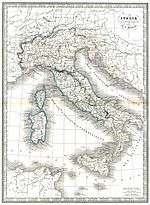 | ||||||||||
|
Early
|
||||||||||
|
||||||||||
|
Post-Roman Kingdoms
|
||||||||||
|
Medieval
|
||||||||||
|
Early modern
|
||||||||||
|
Modern
|
||||||||||
|
| ||||||||||
Archaic Italy
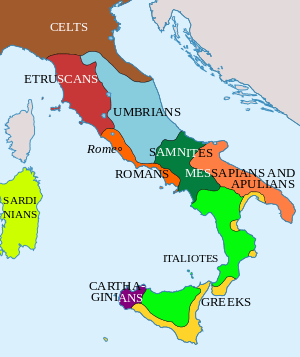
Early Middle Ages
- Kingdom of Italy
- Ostrogothic Kingdom[1]
- Lombard Kingdom
- Duchy of Rome (under the Byzantine Empire)
- Exarchate of Ravenna (under the Byzantine Empire)
- Exarchate of Carthage (under the Byzantine Empire)
- Thema of Sicily (under the Byzantine Empire)
- Duchy of Benevento
- Duchy of Spoleto
- Papal States
- Kingdom of Italy (under the Carolingian Empire)
- Catepanate of Italy (under the Byzantine Empire)
High Middle Ages

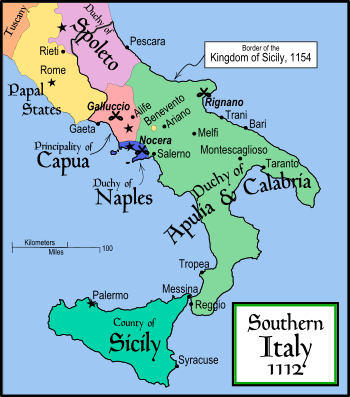
States of the Holy Roman Empire
- Kingdom of Italy (also called Kingdom of Lombardy)
- Duchy of Milan
- March of Tuscany
- March of Verona
- March of Treviso
- March of Ivrea
- March of Turin
- March of Montferrat
- March of Genoa
- Patriarchate of Aquileia (including March of Friuli and March of Istria)
- Duchy of Spoleto
- Bishopric of Brixen
- Bishopric of Trent
- County of Savoy
- County of Gorizia
- Marquisate of Saluzzo
- Marquisate of Ceva
- Marquisate of Incisa
- Marquisate of Finale
States in Southern Italy
- Catepanate of Italy (under the Byzantine Empire)
- Principality of Benevento
- Principality of Salerno
- Principality of Capua
- Duchy of Gaeta
- Duchy of Naples
- Duchy of Amalfi
- Duchy of Sorrento
- Emirate of Sicily (under the Fatimid Caliphate)
- County of Sicily
- County of Apulia
- Duchy of Apulia
- Duchy of Calabria
- Duchy of Apulia and Calabria
- Kingdom of Sicily
Late Middle Ages

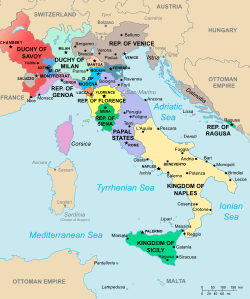
- Papal States
- Rebel city-states in Papal States
- Kingdom of Naples
- Kingdom of Sicily
- Kingdom of Sardinia and Corsica
- Duchy of Milan
- Duchy of Ferrara
- Duchy of Modena and Reggio
- Prince-Bishopric of Brixen
- Prince-Bishopric of Trent
- Marquisate of Saluzzo
- Marquisate of Montferrat
- Marquisate of Mantua
- Marquisate of Massa
- Marquisate of Finale
- Marquisate of Incisa
- Marquisate of Ceva
- Marquisate of Fosdinovo
- Marquisate of Bastia
- County of Savoy (raised to Duchy of Savoy in 1416)
- County of Urbino (raised to Duchy of Urbino in 1443)
- County of Mirandola
- County of Guastalla
- County of Nice (in personal union with Savoy)
- County of Gorizia
- County of Montechiarugolo
- County of Santa Fiora
- County of Asti
- County of Masserano
- County of Correggio
- County of Pitigliano
- County of Novellara
- County of Tende
- County of Sovana
- County of Scandiano
- Republic of Venice
- Republic of Genoa
- Republic of Lucca
- Republic of Florence
- Republic of Siena
- Republic of Ancona
- Republic of Noli
- Republic of Senarica
- Republic of Cospaia
- Republic of Ragusa
- Republic of San Marino
After the Italian Wars (1494–1559)
.png)
Under the terms of the Peace of Cateau-Cambrésis in 1559, at the end of the Italian Wars, only the Papacy and Venice remained fully independent. Sardinia, Sicily, Naples (inclusive of the State of Presidi) were under direct control of the Spanish Habsburgs. France ended its claims in Tuscany, Piedmont and Genoa, confirmed as Imperial fiefs in Italy of the Austrian Habsburgs ruled by local families. Milan was an Imperial fief held by Spain. Therefore, the House of Habsburg became the main foreign force in the Italian peninsula.
Major states
- Papal States
- Kingdom of Naples (under Habsburg Spain)
- Kingdom of Sicily (under Habsburg Spain)
- Kingdom of Sardinia (under Habsburg Spain)
- Duchy of Savoy (Imperial fief)
- Duchy of Florence (Imperial fief raised to Grand Duchy of Tuscany in 1569)
- Duchy of Milan (Imperial fief under Habsburg Spain)
- Republic of Genoa (Imperial fief)
- Republic of Venice
Minor states
- Duchy of Mantua
- Duchy of Parma and Piacenza
- Duchy of Ferrara
- Duchy of Modena and Reggio (In personal union with Ferrara)
- Duchy of Urbino
- Duchy of Castro (in personal union with Parma)
- Prince-Bishopric of Brixen
- Prince-Bishopric of Trent
- Principality of Piombino
- Principality of Monaco
- Marquisate of Montferrat (raised to Duchy of Montferrat in 1574; in personal union with Mantua)
- Marquisate of Masserano (raised to Principality of Masserano in 1598)
- Marquisate of Sabbioneta (raised to Duchy of Sabbioneta in 1577)
- Marquisate of Finale
- Marquisate of Massa (raised to Principality of Massa in 1568)
- Marquisate of Carrara (in personal union with Massa)
- Marquisate of Castiglione (raised to Principality of Castiglione in 1609)
- Marquisate of Torriglia
- Marquisate of Fosdinovo
- Marquisate of Bastia
- County of Guastalla
- County of Mirandola
- County of Montechiarugolo
- County of Correggio (raised to Principality of Correggio in 1616)
- County of Novellara
- County of Pitigliano
- County of Tende
- County of Santa Fiora
- Republic of Ancona
- Republic of Lucca
- Republic of Ragusa
- Republic of San Marino
- Republic of Noli
- Republic of Senarica
- Republic of Cospaia
- Malta (ruled by the Knights Hospitaller)
After the Wars of Succession of the XVIII century

Following the European wars of succession of the XVIII century, several states in central-north Italy were ruled by the Habsburg-Lorraine from Austria. Southern Italy passed to a cadet branch of the Spanish Bourbons.
- Papal States
- Kingdom of Naples (under Habsburg Monarchy up to 1734; in personal union with Naples under the Spanish Bourbons thereafter)
- Kingdom of Sicily (under Savoy from 1714 to 1720; under Habsburg Monarchy from 1720 to 1734; in personal union with Naples under the Spanish Bourbons thereafter)
- Kingdom of Sardinia (under Habsburg Monarchy from 1714 to 1720; in personal union with Savoy thereafter)
- Grand Duchy of Tuscany (under Habsburg-Lorraine after 1737)
- Duchy of Savoy
- Duchy of Milan (under Habsburg Monarchy)
- Duchy of Mantua (under Habsburg Monarchy)
- Duchy of Parma and Piacenza (under Habsburg Monarchy from 1734 to 1748)
- Duchy of Guastalla (in personal union with Parma from 1748)
- Duchy of Modena and Reggio
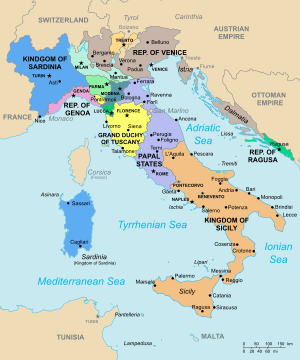 Political map of Italy in the year 1796
Political map of Italy in the year 1796 - Duchy of Massa and Carrara (in personal union with Modena from 1731)
- Duchy of Mirandola (in personal union with Modena from 1710)
- Prince-Bishopric of Brixen
- Prince-Bishopric of Trent
- Principality of Masserano
- Principality of Torriglia
- Principality of Piombino
- Principality of Monaco
- Marquisate of Fosdinovo
- Marquisate of Bastia
- Republic of Venice
- Republic of Genoa
- Republic of Lucca
- Republic of San Marino
- Republic of Ragusa
- Republic of Noli
- Republic of Senarica
- Republic of Cospaia
- City of Fiume and its District
During Napoleonic times (1792–1815)
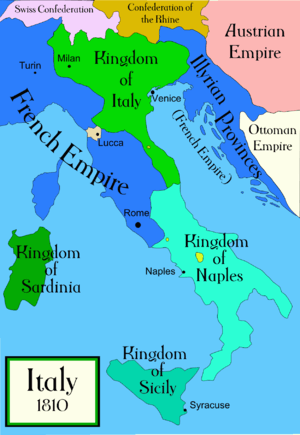
Sister republics of Revolutionary France
- Republic of Alba
- Republic of Bergamo
- Republic of Brescia
- Republic of Crema
- Republic of Pescara
- Piedmontese Republic
- Anconine Republic
- Cispadane Republic
- Transpadane Republic
- Cisalpine Republic
- Subalpine Republic
- Ligurian Republic
- Bolognese Republic
- Tiberina Republic
- Roman Republic
- Parthenopean Republic
- Italian Republic
In personal union with France
Client states of the First French Empire
- Kingdom of Etruria
- Kingdom of Naples
- Principality of Lucca and Piombino
- Principality of Benevento
- Principality of Pontecorvo
Other states
- Kingdom of Sardinia
- Kingdom of Sicily
- Principality of Elba (non-hereditary Monarchy under the exiled Emperor Napoleon)
- Republic of San Marino
- Republic of Cospaia
From the Restoration to the Unification
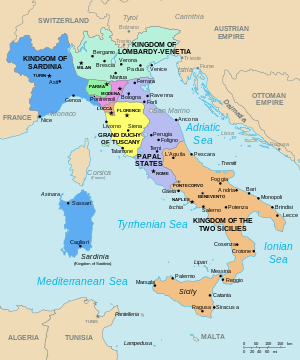
Following the defeat of Napoleon's France, the Congress of Vienna (1815) was convened to redraw the European continent. In Italy, the Congress restored the pre-Napoleonic patchwork of independent governments, either directly ruled or strongly influenced by the prevailing European powers, particularly Austria. The Congress also determined the end of two millenary republics: Genoa was annexed by the then Savoyard Kingdom of Sardinia, and Venice was incorporated with Milan into a new kingdom of the Austrian Empire.
At the time, the struggle for Italian unification was perceived to be waged primarily against the Habsburgs, since they directly controlled the predominantly Italian-speaking northeastern part of present-day Italy and were the most powerful force against the Italian unification. The Austrian Empire vigorously repressed nationalist sentiment growing on the Italian peninsula, as well as in the other parts of Habsburg domains.
- Papal States
- Kingdom of Sardinia
- Kingdom of the Two Sicilies
- Kingdom of Lombardy–Venetia (under Austrian Empire)
- Kingdom of Illyria (under Austrian Empire)
- Grand Duchy of Tuscany
- Duchy of Parma, Piacenza and Guastalla
- Duchy of Modena and Reggio
- Duchy of Massa and Carrara
- Duchy of Lucca
- Principality of Monaco
- Republic of San Marino
- Republic of Cospaia
- Republic of San Marco
- Roman Republic
- United Provinces of Central Italy
Post-unification
See also
- List of former sovereign states
- List of historic states of Russia
- List of historic states of Germany
- List of historical states of Georgia


.jpg)